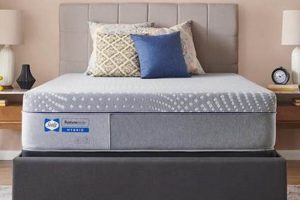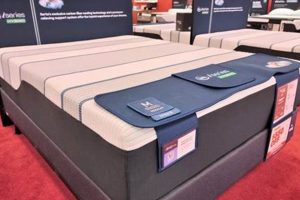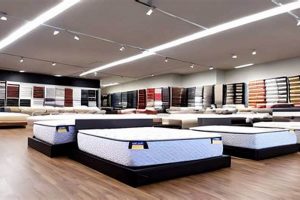A sleep surface offering minimal give and maximum support characterizes the top end of the firmness scale in bedding. These sleeping platforms are designed to maintain a rigid structure, offering very little contouring to the body’s shape. For example, a mattress constructed with high-density foams and a tightly woven, thick cover will generally exhibit characteristics consistent with this level of firmness.
This type of bed plays a crucial role in addressing specific sleep needs and preferences. Historically, individuals with certain medical conditions or those who simply prefer an unyielding sleep experience have sought out these options. The potential benefits include enhanced spinal alignment and reduced pressure on joints for individuals who sleep on their stomach or back. Furthermore, the robust structure contributes to increased durability and longevity compared to softer alternatives.
The subsequent sections will delve into the specific advantages and disadvantages of utilizing this exceptionally firm sleeping surface, the ideal sleeper profiles for its use, and how it compares to other firmness levels available on the market. Consideration will also be given to the materials commonly employed in its construction and the factors impacting its overall cost.
Tips for Choosing a Super Firm Mattress
Selecting a sleep surface at the extreme end of the firmness spectrum necessitates careful consideration. The following recommendations aim to inform potential purchasers regarding key factors to evaluate before making a decision.
Tip 1: Assess Sleep Position: Individuals who primarily sleep on their stomach or back may derive the most benefit. The unyielding surface can aid in maintaining spinal alignment and preventing excessive sinking, which can lead to discomfort.
Tip 2: Consider Body Weight: Those with higher body weights often find sufficient support in a rigid mattress. The firmness prevents excessive compression and ensures that the sleeper remains properly supported throughout the night.
Tip 3: Evaluate Medical Conditions: Consult with a healthcare professional regarding the suitability if pre-existing back problems or other musculoskeletal conditions are present. A super firm option may or may not be appropriate depending on the specific condition.
Tip 4: Check Material Composition: Examine the mattress construction, paying particular attention to the density of the foam or the gauge of the coils. Higher density and lower gauge typically indicate greater firmness and support.
Tip 5: Inquire About Trial Periods: Given the highly individualized nature of comfort, seek out manufacturers or retailers offering trial periods. This allows for an assessment of suitability without a long-term commitment.
Tip 6: Pay Attention to Edge Support: Super firm varieties generally exhibit superior edge support compared to softer alternatives. Evaluate this feature, particularly if the mattress will be used by multiple individuals or if sitting on the edge is a frequent occurrence.
Tip 7: Understand Firmness Ratings: Recognize that “super firm” is a relative term. Firmness ratings can vary across manufacturers, so it is crucial to read reviews and consult specifications to understand the level of firmness being offered.
In summary, appropriate selection requires careful consideration of sleep position, body weight, pre-existing medical conditions, material composition, trial periods, edge support, and an understanding of manufacturer-specific firmness ratings. Prioritizing these factors can significantly improve the likelihood of a satisfactory purchase.
The concluding sections will address common misconceptions associated with this type of sleep surface and provide guidance on proper care and maintenance to prolong its lifespan.
1. Spinal Alignment and Super Firm Mattresses
The primary purported benefit of a super firm mattress lies in its ability to promote optimal spinal alignment. When an individual lies down, the spine should maintain its natural curvature to minimize stress on joints and muscles. A too-soft mattress allows the heavier parts of the body, such as the hips and shoulders, to sink in excessively, potentially distorting this alignment. A super firm mattress, by contrast, resists this sinking, thereby keeping the spine closer to its natural position. The efficacy of a super firm mattress in achieving this optimal alignment is directly proportional to its ability to maintain a flat, unyielding surface.
Achieving proper spinal alignment during sleep can have several positive effects. It may reduce morning stiffness, alleviate lower back pain, and improve overall sleep quality. For example, individuals with lordosis (an exaggerated inward curve of the lower back) may find that a super firm mattress prevents further exacerbation of their condition by preventing the pelvis from tilting excessively forward during sleep. The importance of understanding this connection is that it allows consumers to make informed decisions about mattress selection based on their individual physical needs and predispositions. This alignment then becomes a crucial component of the mattress’s efficacy.
However, it is essential to note that “optimal” spinal alignment is not a universally applicable concept. Individuals with certain body types or pre-existing conditions may not benefit from a super firm mattress. Therefore, while a super firm mattress can potentially contribute to spinal alignment, it is not a panacea and should be selected after careful consideration of individual needs and, ideally, consultation with a healthcare professional. Choosing what works best is an issue of personal health.
2. Minimal contouring
Minimal contouring, a defining characteristic of super firm mattresses, directly correlates with the rigid surface they present. This reduced capacity to conform to the body’s shape results from the high-density materials and construction techniques employed. The effect is a sleeping surface that remains largely flat and resists compression, even under considerable weight. The importance of this minimal contouring lies in its ability to provide uniform support across the entire body, preventing specific areas from sinking in and disrupting spinal alignment. For instance, a stomach sleeper on a less firm mattress might experience a pronounced arch in their lower back, but the lack of contouring in a super firm mattress distributes weight more evenly, mitigating this risk.
The practical significance of this understanding extends to therapeutic applications. Medical professionals may recommend super firm mattresses with minimal contouring for individuals recovering from specific back injuries or surgeries, where maintaining a stable and consistent spinal position is critical for healing. Furthermore, the consistent support can
aid in reducing pressure points for individuals who prefer sleeping on their back, distributing weight evenly across the skeletal structure. The consistent resistance provided helps to maintain good skeletal health through improved sleeping posture.
In summary, the connection between minimal contouring and the super firm mattress is fundamental. The former is a deliberate design element to accomplish the latter. This design choice delivers consistent support, reduces spinal misalignment, and may offer therapeutic benefits. The selection of a mattress with minimal contouring should, however, be undertaken with careful consideration of individual needs and preferences to ensure optimal sleep comfort and support. This choice can improve the individual’s sleeping and skeletal health when matched correctly.
3. High-density materials
High-density materials are a fundamental component in the construction of any super firm mattress. The cause-and-effect relationship is straightforward: the greater the density of the materials used, the firmer the resulting sleep surface. This density is achieved through the selection of specific materials, such as high-density foams, tightly-coiled innerspring systems with a low gauge, or combinations of both. The importance of these high-density components cannot be overstated; they are the primary determinants of the mattress’s unyielding nature and its capacity to provide consistent support. For instance, a super firm mattress employing a high-density polyurethane foam core will exhibit significantly less compression and greater resistance compared to one utilizing low-density foam. This enhanced resistance is what creates the distinct sensation of firmness.
The practical significance of understanding the role of high-density materials extends to issues of mattress longevity and durability. Mattresses constructed with these materials are generally more resistant to sagging and deformation over time. A mattress employing high-density latex, for example, will retain its firmness and support characteristics for a longer period than one made with lower-density materials, potentially extending the useful life of the product. This directly translates to a reduced frequency of replacement and, consequently, a lower total cost of ownership. Furthermore, the utilization of such materials often contributes to improved motion isolation, minimizing the transfer of movement between sleeping partners.
In summary, the density of constituent materials is intrinsically linked to the characteristics of a super firm mattress. This connection impacts not only the initial firmness and support provided, but also the long-term durability and overall value of the product. The informed consumer will therefore pay close attention to the density specifications of the materials used in order to make an educated purchasing decision, aligning their choice with their specific needs and preferences.
4. Stomach Sleepers and Super Firm Mattresses
The correlation between stomach sleeping and the suitability of a super firm mattress arises from biomechanical considerations. When sleeping prone, the body’s weight is concentrated in the midsection, leading to potential spinal misalignment if the mattress yields excessively. This misalignment can manifest as hyperextension of the lumbar spine, placing undue stress on the vertebrae and surrounding musculature. A super firm mattress counteracts this tendency by providing a stable and unyielding surface, preventing the midsection from sinking too deeply and maintaining a more neutral spinal alignment. For example, an individual with a higher body mass index may find that a super firm surface mitigates spinal strain when sleeping on their stomach.
The practical significance of this understanding lies in mitigating potential musculoskeletal issues. Chronic back pain is frequently associated with poor sleeping posture, and the selection of an inappropriate mattress can exacerbate this problem. By providing adequate support and preventing excessive spinal curvature, a super firm mattress may help to alleviate discomfort and promote better sleep quality for stomach sleepers. Furthermore, this choice can impact breathing patterns, reducing compression on the diaphragm and facilitating more efficient respiration. However, it is crucial to recognize that individual needs vary; some stomach sleepers may find a super firm surface too rigid, necessitating a compromise with a slightly softer, yet still supportive, option. An appropriately chosen mattress contributes positively to skeletal health.
In conclusion, while a super firm mattress can offer benefits for stomach sleepers by promoting spinal alignment and reducing musculoskeletal stress, it is not a universally optimal solution. Individual factors, such as body weight, spinal curvature, and personal comfort preferences, must be carefully considered. A trial period or consultation with a healthcare professional can provide valuable insights to determine the suitability of a super firm mattress for a given individual’s specific needs. The crucial point remains the proper matching of mattress type to individual health needs.
5. Weight distribution
Weight distribution, in the context of a super firm mattress, describes how body weight is supported and dispersed across the surface. This distribution is critical for comfort, support, and long-term mattress performance. Even distribution minimizes pressure points and contributes to spinal alignment.
- Minimizing Pressure Points
An effectively designed mattress prevents excessive pressure buildup at specific points, such as the shoulders, hips, and heels. A super firm mattress achieves this through its inherent rigidity, resisting localized sinking. This is particularly relevant for individuals with conditions like arthritis, where pressure point relief is essential for pain management and improved sleep quality.
- Maintaining Spinal Alignment
Proper weight distribution facilitates optimal spinal alignment, regardless of sleep position. The unyielding surface of a super firm mattress prevents the spine from curving unnaturally, especially in the lumbar region. For example, a stomach sleeper benefits from reduced arching in the lower back, a common issue when the midsection sinks into a softer mattress. This alignment then reduces skeletal stress and discomfort.
- Impact on Circulation
Uneven weight distribution can impede circulation, leading to discomfort and potential health issues. A super firm mattress promotes consistent weight dispersal, minimizing constriction of blood vessels. Consider an individual with vascular problems; reduced pressure on extremities contributes to improved blood flow and reduced risk of numbness or tingling.
- Mattress Longevity
Weight distribution also influences the lifespan of the sleep surface. Even distribution minimizes localized wear and tear, preventing sagging and indentations over time. A super firm mattress, due to its robust construction, maintains its shape and support characteristics for longer, ensuring sustained performance and v
alue. This durability makes them more cost effective than softer mattresses.
In summary, weight distribution is a core function of a super firm mattress, impacting comfort, health, and product longevity. Even dispersal of weight across the mattress is necessary for minimizing pressure points, preserving spinal alignment, optimizing circulation, and maintaining mattress integrity. Selecting a mattress is therefore a health decision. The advantages of effective weight distribution make a super firm mattress a suitable option for individuals with specific needs and preferences.
6. Durability, longevity
The terms durability and longevity, when applied to a super firm mattress, denote its capacity to withstand prolonged use while maintaining its structural integrity and performance characteristics. The construction of this type of mattress often involves high-density materials and reinforced designs specifically intended to resist sagging, compression, and deformation over time. The inherent firmness of the mattress reduces the degree to which it conforms to the body, thereby minimizing stress on individual components. Consequently, the mattress retains its original shape and support for a longer period, compared to softer alternatives. For instance, a super firm mattress composed of high-density latex or tightly-coiled steel springs may provide consistent support for a decade or more, while a softer mattress might exhibit noticeable sagging within a few years.
The practical significance of this durability and longevity lies in the long-term economic benefits and sustained health advantages. A longer lifespan translates to a reduced frequency of replacement, thus lowering the overall cost of ownership. Moreover, a durable mattress ensures consistent support over time, preventing the development of pressure points and spinal misalignments that can contribute to chronic pain or discomfort. Consider a scenario where an individual with a pre-existing back condition invests in a super firm mattress; the mattress’s ability to maintain its firmness and support can help to alleviate pain and improve sleep quality for an extended period, potentially reducing reliance on pain medication or other interventions. The consistent structure is vital for consistent support of the human skeletal system.
In summary, the durability and longevity of a super firm mattress are critical attributes stemming from its robust construction and inherent firmness. These factors not only contribute to economic savings over the long term but also play a vital role in maintaining consistent support and promoting musculoskeletal health. Consumers considering a super firm mattress should prioritize models constructed with high-quality materials and reinforced designs to ensure sustained performance and value, thereby deriving the maximum benefit from their investment. The long term use is of key consideration to maximizing benefit and value.
Frequently Asked Questions
The following questions and answers address common inquiries and misconceptions concerning sleep surfaces characterized by extreme firmness. The information presented aims to provide clarity and guidance for potential purchasers and users.
Question 1: Is a super firm mattress appropriate for all individuals?
No, its suitability is highly individualized. Those who primarily sleep on their stomach or back, and those with higher body weights, may find it beneficial. However, individuals with certain pre-existing musculoskeletal conditions, or those who prefer a more conforming sleep surface, may find it uncomfortable or even detrimental. Consultation with a healthcare professional is recommended.
Question 2: Can a super firm mattress alleviate back pain?
It may alleviate some types of back pain by promoting spinal alignment. However, its effectiveness depends on the underlying cause of the pain. It is not a universal solution, and in some cases, it may exacerbate certain conditions. A proper assessment by a medical professional is crucial.
Question 3: What materials are commonly used in its construction?
High-density foams (polyurethane or latex), tightly-coiled innerspring systems with low gauge (thick) coils, or a combination of both are typically employed. The density and quality of these materials directly impact the firmness and durability of the mattress.
Question 4: How does it compare to a memory foam mattress?
Super firm mattresses offer minimal contouring, prioritizing support over pressure relief. Memory foam mattresses, conversely, excel at conforming to the body’s shape and distributing weight. The choice depends on individual preferences and needs. They offer very different support and comfort qualities.
Question 5: Will a super firm mattress soften over time?
Some softening is normal, but a high-quality super firm mattress should maintain its firmness characteristics for an extended period. The use of high-density materials and proper care (e.g., regular rotation) can minimize this softening.
Question 6: Where can one find a super firm mattress?
It is available at most major mattress retailers, both online and in brick-and-mortar stores. When purchasing online, ensure the vendor has a clear return policy. Visiting a showroom is advisable to test firmness levels personally.
In summary, its suitability varies considerably depending on individual factors, underlying health conditions, and preference for sleeping position. Consultation with healthcare and proper trial periods are recommended for best results.
The concluding section will present a maintenance strategy to improve the lifespan of super firm mattresses.
Super Firm Mattress
This exploration of the super firm mattress has elucidated its defining characteristics, suitability parameters, and potential benefits. The analysis underscored the critical role of high-density materials in maintaining the surface’s unyielding nature, and the importance of considering individual sleep position, body weight, and pre-existing medical conditions. Furthermore, the discussion addressed common misconceptions and provided practical guidance on selecting and maintaining this type of sleep surface. The suitability varies greatly for individuals depending on their health and needs.
Ultimately, the decision to utilize a super firm mattress demands careful consideration. Prospective purchasers should prioritize informed decision-making, potentially consulting healthcare professionals and taking advantage of trial periods to assess individual compatibility. The selection of an appropriate sleep surface represents an investment in long-term health and well-being, therefore the choice must be deliberate and well-informed. Future research should continue to explore the long-term impact of different mattress types on musculoskeletal health and sleep quality.







